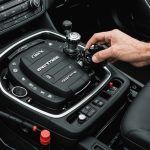Spotting and Solving Common ECU Problems in UK Vehicles: A Comprehensive Guide
Understanding the ECU: The Brain of Your Car
The Engine Control Unit (ECU) is the central computer of your vehicle, responsible for managing and controlling various engine and vehicle functions. It is essentially the brain of your car, making it crucial for the smooth operation of your vehicle. The ECU receives data from numerous sensors scattered throughout the car, such as the oxygen sensor, coolant temperature sensor, and oil pressure sensor, to name a few. This data is then used to adjust engine parameters like fuel injection, ignition timing, and emission control.
Common ECU Problems in UK Vehicles
ECU problems can manifest in various ways, often leading to frustrating and sometimes costly repairs. Here are some common issues you might encounter:
Also to read : How does the UK’s weather affect your vehicle, and what precautions should you take?
Warning Lights and Error Codes
One of the most obvious signs of an ECU problem is the illumination of the warning light on your dashboard. This light can indicate a wide range of issues, from minor problems like a loose gas cap to more serious issues like a faulty oxygen sensor or engine misfire.
- Check Engine Light: This is the most common warning light related to ECU issues.
- Service Engine Soon Light: Similar to the check engine light, but often less urgent.
- Oil Pressure Light: Indicates low oil pressure, which can be critical for engine health.
Performance Issues
ECU problems can also affect the performance of your vehicle. Here are a few examples:
This might interest you : Ultimate guide to ceramic coating in kent: protect your ride
- Poor Engine Performance: This could include rough idling, stalling, or a lack of power.
- Transmission Problems: Erratic shifting or failure to shift into gear can be ECU-related.
- Fuel Efficiency: A malfunctioning ECU can lead to poor fuel economy.
Battery and Electrical Issues
Sometimes, ECU problems can be linked to battery and electrical system malfunctions.
- Dead Battery: If the ECU is not shutting down properly, it can drain the battery.
- Electrical System Malfunctions: Issues with the alternator, like the Mercedes alternator, can affect ECU function.
Diagnostic Tools: Your Best Friend in Troubleshooting
To identify and solve ECU problems, you need the right diagnostic tools. Here are some of the most effective tools available:
OBD2 Scanners
OBD2 (On-Board Diagnostics II) scanners are essential for diagnosing ECU issues. These tools connect to your vehicle’s OBD2 port and provide detailed information about the vehicle’s systems.
- **KINGBOLEN K10**: This scanner offers 41+ reset services, bidirectional control, and topology mapping. It can read and clear error codes, perform active tests, and provide live data streams[3].
- **LAUNCH CRP919E BT**: This tool provides comprehensive diagnostic help with detailed explanations, probable causes, and troubleshooting instructions for each error code[4].
#### Advanced Diagnostic Functions
Modern diagnostic tools go beyond basic OBD2 functions, offering advanced features like:
plaintext
- ECU Coding and Programming: Tools like the KINGBOLEN K10 and LAUNCH X431 Pro3S+ allow for ECU coding and programming, which can unlock hidden features or reset components after replacement[3][5].
- Topology Mapping: This feature helps visualize the communication structure between different ECU modules, making it easier to diagnose complex issues[3].
- Bidirectional Control: This allows you to send commands to the ECU to perform active tests on various components, such as the EVAP system or fuel injectors[3].
Step-by-Step Guide to Diagnosing ECU Problems
Diagnosing ECU problems can seem daunting, but with the right approach, it becomes more manageable. Here’s a step-by-step guide:
Connect the Diagnostic Tool
Start by connecting your OBD2 scanner to the vehicle’s OBD2 port. Ensure the vehicle is turned on but not started.
Read Error Codes
Use the scanner to read any error codes stored in the ECU. These codes will give you a starting point for your diagnosis.
Analyze Live Data
Obtain live data streams from various sensors to see how the vehicle is performing in real-time. This can help identify issues that may not trigger an error code.
Perform Active Tests
Use the bidirectional control feature to perform active tests on specific components. For example, you can test the solenoid of the EVAP system or cycle the ABS pump to see if it’s functioning correctly[3].
Reset and Reinitialize Components
After repairing or replacing components, use the diagnostic tool to reset and reinitialize them. This is crucial for ensuring the ECU recognizes the new components and adjusts its parameters accordingly.
Practical Tips and Advice
Here are some practical tips to keep in mind when diagnosing and solving ECU problems:
Keep Your Diagnostic Tool Updated
Many diagnostic tools, like the KINGBOLEN K10, offer free updates for several years. Keeping your tool updated ensures you have access to the latest features and vehicle coverage[3].
Consult the User Manual
Each diagnostic tool comes with a user manual that explains its functions in detail. Take the time to read through it to get the most out of your tool.
Join Online Communities
Online forums and communities can be invaluable resources. Many mechanics and DIY enthusiasts share their experiences and tips on diagnosing and fixing ECU issues.
Real-Life Examples and Anecdotes
The Case of the Faulty Oxygen Sensor
A common issue many car owners face is a faulty oxygen sensor. Here’s an example of how to diagnose and fix this problem:
- Connect the OBD2 scanner and read the error code. If it indicates an oxygen sensor issue, proceed to the next step.
- Use the live data function to monitor the oxygen sensor's readings. If the sensor is faulty, the readings will be inconsistent or out of range.
- Perform an active test on the oxygen sensor using the bidirectional control feature.
- Replace the oxygen sensor if it's found to be faulty.
- Reset the ECU using the diagnostic tool to ensure it recognizes the new sensor.
The Mercedes Alternator Issue
Sometimes, what seems like an ECU problem can actually be related to another component. Here’s an example involving a Mercedes alternator:
- A Mercedes owner noticed their car's battery was draining quickly. The warning light indicated an electrical system issue.
- Using an OBD2 scanner, the owner found no specific error codes related to the ECU.
- Further investigation revealed that the alternator was not charging the battery properly.
- Replacing the alternator and resetting the electrical system using the diagnostic tool resolved the issue.
Diagnosing and solving ECU problems in UK vehicles can be a complex task, but with the right tools and a systematic approach, it becomes much more manageable. By understanding how the ECU works, using advanced diagnostic tools, and following practical tips, you can save time and money while ensuring your vehicle runs smoothly.
Remember, the key to successful diagnosis is patience and thoroughness. Always consult the user manual of your diagnostic tool, and don’t hesitate to seek advice from online communities or professional mechanics if you’re unsure about any step of the process.
In the words of a seasoned mechanic, “The ECU is like the heart of your car. Keeping it healthy and functioning properly is crucial for the overall performance and longevity of your vehicle.” By following this guide, you’ll be well on your way to becoming an expert in spotting and solving common ECU problems in your car.
Repair and Replacement Options
Navigating vehicle maintenance often involves deciding between ECU repair and replacement. Both options have distinct advantages and considerations. ECU repair is typically the more cost-effective choice and can be ideal if the issue is minor or if the unit can be restored to optimal functioning. However, in cases where damage is severe, an ECU replacement may be necessary for ensuring reliability and performance.
Factors to Consider
- Extent of Damage: A minor fault may lend itself well to quick repair. But for extensive damage, replacement might be unavoidable.
- Cost and Availability: Compare repair costs against purchasing a new or refurbished ECU. Availability of parts, especially for older vehicle models, plays a crucial role in decision-making.
- Longevity and Performance: When evaluating the two options, consider how each affects vehicle longevity and performance.
Replacing an ECU: Step-by-Step
In the UK, replacing an ECU involves:
- Disconnecting the battery.
- Locating and removing the faulty ECU.
- Installing the new ECU following the manufacturer’s guidelines.
- Reprogramming the ECU to ensure functionality and compatibility with the vehicle.
Preventive Measures and Best Practices
Preventive maintenance is crucial for optimal vehicle care, especially regarding the Electronic Control Unit (ECU), the vehicle’s brain. Routine checks can preempt potential problems. Drivers should regularly inspect wiring connections for signs of corrosion or wear and ensure software updates are performed in a timely manner. These simple actions help mitigate ECU issues before they escalate.
Educating drivers on best practices for ECU care is equally important. Many overlook the impact of poor driving habits on the ECU, such as abrupt stops or rapid accelerations, which can lead to unnecessary stress on the vehicle’s systems. As part of regular vehicle care, it’s beneficial to teach them about smooth driving techniques.
Using quality parts and services cannot be overstated when discussing vehicle maintenance. Employing cheap, low-quality parts can compromise the ECU’s efficiency and reliability, leading to expensive repairs. Sourcing parts from reputable suppliers and hiring skilled technicians ensure the best outcomes for your vehicle’s performance. Owners should make informed decisions and prioritise quality over cost in maintenance practices for long-term reliability.
In comprehensive vehicle care, these elements work together seamlessly, allowing drivers to maintain their cars effectively while avoiding potential pitfalls.
Regulatory Considerations and Compliance in the UK
Understanding the UK Vehicle Regulations is crucial for anyone looking to modify an Engine Control Unit (ECU). Compliance is not just about safety; it significantly impacts vehicle performance. UK regulations are stringent when it comes to ECU modifications. This ensures vehicles meet specific Automotive Standards for emissions, noise, and general safety. Non-compliance can lead to penalties, so staying informed is essential.
Modifying an ECU without adhering to these standards can adversely affect safety and performance. It might also void your vehicle’s insurance or warranty. Hence, ECU Compliance isn’t just a legal necessity but a wise choice for safeguarding your vehicle.
To keep abreast of legal requirements, vehicle owners can consult resources like the Driver and Vehicle Standards Agency (DVSA) and Vehicle Certification Agency (VCA). These bodies offer comprehensive guidelines on maintaining compliance with automotive standards. Additionally, automotive forums and workshops often provide insights into the latest regulations, helping owners make informed decisions about modifications.
In the evolving landscape of vehicle regulations, maintaining compliance ensures both the performance and legality of your vehicle.
FAQs about ECU Issues
When dealing with ECU issues, drivers often have numerous questions. Here, we address some of the most frequently asked questions to assist you in troubleshooting and understanding your vehicle’s ECU.
What is an ECU and what role does it serve?
The Engine Control Unit (ECU) serves as the vehicle’s central computer, managing engine operations by processing data from various sensors. It optimises fuel injection, ignition timing, and airflow to ensure efficient performance.
What are common signs of ECU problems?
Symptoms often include:
- Unexpected reduction in fuel efficiency
- Unresponsive or erratic engine behaviour
- Trouble starting the vehicle
These indicators may suggest deeper ECU issues and warrant further ECU troubleshooting.
Can I fix ECU problems myself, or should I consult a professional?
ECU issues typically require professional expertise due to the complexity of system diagnostics. DIY fixes might trigger further complications if not handled carefully.
Where can I find additional resources for ECU learning?
Automotive forums, manufacturer manuals, and specialised repair courses offer valuable insights for understanding and addressing ECU challenges. Always ensure sources are reliable to get accurate information.
Gain confidence in resolving ECU problems efficiently by utilising the right resources for clear guidance and practical solutions.
Glossary of ECU Terminology
Understanding ECU terminology is crucial for anyone navigating the automotive landscape, especially as vehicles become more technologically advanced. Let’s explore key terms to help demystify this automotive language.
Electronic Control Unit (ECU): The ECU is a critical component in modern vehicles. It acts as the brain of the car, managing and controlling various functions such as engine operations, fuel injection, and emissions.
OBD-II: On-Board Diagnostics II is a standardised system that monitors vehicle health. When something is amiss, codes are stored in the ECU to help diagnose the issue.
CAN Bus: This is a network for communication among different parts of a vehicle, like ECUs, allowing them to exchange information. It ensures all components work harmoniously.
Firmware: The software embedded in ECUs to control their functions. This is essential for updating and improving vehicle performance without hardware changes.
Understanding these terms empowers car owners and enthusiasts by providing clarity on how their vehicles operate. As technology continues to evolve, staying informed about ECU terminology enhances your ability to make informed decisions about vehicle maintenance and upgrades.











